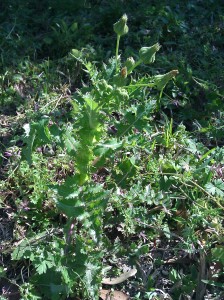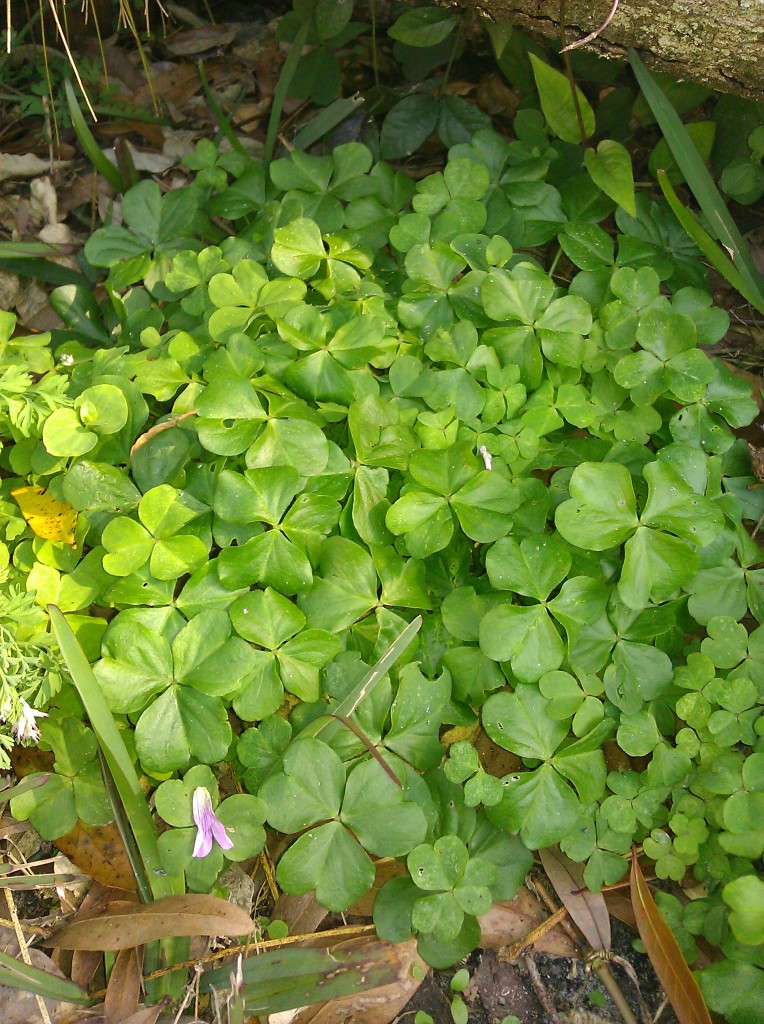
My child’s school class went on a field trip last week to a local, community organic farm. This excursion afforded the children the unique opportunity to plant seeds, weed the rows of vegetables, harvest the crop and even feed the free range chickens! After the children had picked a basketful of lettuce from the rows of carefully tended vegetables, our knowledgeable guides rinsed and prepared a salad with the harvest for everyone to enjoy with lunch.
It was a fantastic learning experience for the children as well as the parents.
As someone who has been “into organic” for almost 20 years, most of what we went over during the field trip was already common knowledge to me. We all have something to learn from just about every experience, however, and this field trip was no exception. During the tour through the farm’s greenhouse, I was shocked to see at least 4 herbs growing that I have seen for years growing wild in my yard!
Imagine that? A veritable garden in my yard without me even knowing it!
So, what are these lovely plants growing right under my nose that I’ve been ignorantly weed wacking and mowing for the past 18 years? The fab four are: fennel, thyme, oxalis, and nettle! I’ve even blogged about nettle before – it’s one of my all time favorite herbs. There are probably many other plants in my yard that I could use for cooking as well, considering that I have never used pesticides on my yard in the 18 years I’ve lived in this house and the entire 2 acres is full of wild, native Florida flora.
If it’s green and it grows, it’s ok by me. I’m not a “perfect lawn” kind of gal.

My next task is to dry the nettle I picked in my yard and start using it for tea instead of the expensive organic nettle tea I’ve been buying at the store. Don’t worry, I won’t poison myself. I made sure to ask my next door neighbor who happens to be a Doctor of Biology at the University of South Florida, to come and verify these plants that I was about to pick and eat!
Besides making tea with the wild nettle, I’m going to try lightly steaming and eating the oxalis. Oxalis is a plant similar to spinach. Both contain the antinutrient oxalic acid which is very irritating to the mouth and digestive tract and is very much linked to kidney stones if consumed frequently. It is best to slightly steam these types of veggies to eliminate the oxalic acid instead of eating them raw, so I won’t be putting them in a salad as suggested by the folks at the community farm.
My kids were especially excited by the discovery that we already have a garden growing with absolutely no effort on our part to water, fertilize or tend it. Just years of careful avoidance of all things poisonous and application of fish fertilizer on our citrus trees and other desirable plants that has obviously brought in a lot of worms is all that it took.
What edible plants do you have growing in your yard? Do you make use of any of them in your cooking?
Sarah, TheHealthyHomeEconomist.com








I like to nibble on lamb’s quarters and purslane from my garden. I think they may have oxalic acid, so a light braising or steaming may be in order.
Last year I got super excited at dandelion season! We went around and picked flowers and leaves. You can make cookies from the flowers, and I dried the leaves. I wish I’d thought/known to dig up the root, too, because we could really use it right now. Suppose I’ll try that in a couple months when it’s dandelion season again.
I also discovered poke berries growing in my yard. I’m aware the berries themselves are poisonous, but the root has quite a lot of medicinal purposes. I didn’t dig it up last year because you have to be very careful to do it at the right time so it isn’t poisonous, too. I will be asking some herbalist friends this year to help.
I’m not sure what else is around, but I’ll be looking! I love things that randomly grow!
This is a great, informative post. I’ve been eating oxalis for years, but I’ve never known what is was called until now. I will make sure to lightly steam it next time. Another abundant edible wild plant is garlic mustard [http://en.wikipedia.org/wiki/Garlic_mustard]. I love its flavor, plus it’s an invasive species by me so I try to remove as much of the stuff as possible. In addition, I know there are a lot of edible berries by me that I’m excited to taste again once it’s get warmer.
We have dandelion weed in our yard, but I’m afraid to use it. My neighbors have a lawn service, and I don’t know if any chemicals have gotten into my yard.
oh, yes, we live in eastern NC, btw
We have chickweed everywhere in our yard from Oct.-May. It is so nutritious. It can be eaten raw or steamed. Later we have sheep sorrel (commonly called sourgrass here), which is one of the herbs in Essiac Tea. It is very expensive to buy at the health food store but we have it in our yard! We harvest it and dehydrate it in our dehydrator and have it for the tea. We also will have oxalis later. The dandelion is coming up now also. It won’t be long before the wild violets either.
It’s really amazing how much free food and medicine is around us. Dandelion is the “weed” that comes to mind that is abundant pretty much everywhere and people try to get rid of it constantly.
Definitely want to learn more about identifying these wild grown weeds and herbs, so I can reap the rewards like you.
http://en.wikipedia.org/wiki/Stinging_nettle
Not to criticise you (or your neighbor)! If we are wrong, please do post where you found that your plant is also nettle. I have a lot of it!
My neighbor said it was a Florida nettle which is slightly different than a stinging nettle but still related and edible.
Sorry to disagree with you neighbor, but that is a thistle, which is not related to stinging nettle (Urtica dioeca) Many plants which sting are called nettle, but that doesn’t mean they are related to true nettles. Common names are confusing in this way, that is why I always try to find actual botanical names. Thistles are edible and healthful but are not a substitute for true stinging nettle if that is what you want to eat or make infusion from.
I would have to agree with Rachael. The nettle I know about is the same as in her link. Perhaps nettle is a common name which multiple plants are known as? I would suggest you figure out the scientific name of the nettle for tea and use that for ID. I ususally call what is in your image a thistle.
sorry, but the top picture isn’t nettle. nettle looks like this: http://www.google.com/images?q=stinging+nettle&oe=utf-8&rls=org.mozilla:en-US:official&client=firefox-a&um=1&ie=UTF-8&source=univ&sa=X&ei=A2ZuTYfdJcL-8AbY8bGjDw&ved=0CCsQsAQ&biw=1432&bih=693
Yeah, I’m pretty sure the first photo is canada thistle after it has bloomed.